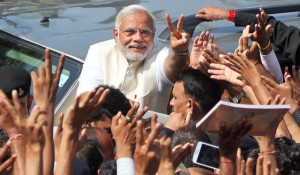UNITED NATIONS — An expected, if still extraordinary, political tsunami has swept across India as voters elected a nationalist and pro-business political party to lead this country of over a billion people.
Riding a wave of voter anger with both ingrained corruption, slowing economic growth and the entitled privilege of the incumbent Congress Party, voters made a break with the past and overwhelmingly chose Narendra Modi’s pro-commerce Bharatiya Janata Party (BJP).

With only a few pauses in continuity, the Congress Party has run India since independence from Britain in 1947. Congress and its dynastic leadership by the Nehru and Gandhi families were identified with “the idea of India,” a democratic, socialist, secular, and non-aligned land but with a growing undertow of corruption and poverty. Only in the 1990’s, under a more reformist Congress Party, did India begin to change and open itself to the outside world.
In the first decades after independence, India was governed by a democratic but socialist model where an anemic Hindu rate of growth at kept a vast land and population at a low gear. During the waves of foreign investment in Southeast Asia in the 1970’s and 1980’s India remained standoffish, preferring instead a self-imposed economic isolation. India’s entrepreneurial and often well- educated people moved abroad, going to Britain, Canada and the USA rather than languishing in a moribund and static economy at home.
This began to change in the 1990’s when the heirs of the authoritarian leader Indira Gandhi decided to open up India and its potential to the outside world. Importantly, the United States under both the Clinton and Bush Administrations eagerly partnered with resurgent India for political and commercial ties.
After the terrorist attacks of September 11, 2001, the Bush Administration established close security links with the New Delhi government in a common front against Islamic extremism. India has sadly had its share of dealing with jihadi terrorism and thus chose a closer security partnership with the USA.
By the early 2000’s India had enthusiastically opened its gates to commerce and trade ties with the U.S. Economically the computer software revolution was helping create a middle class miracle, which has endured and grown impressively. Thus the global perception, or old stereotypes of India, has changed drastically.
To its credit, the economic reforms of Congress and its long serving and competent Prime Minister Manmohan Singh put India on a better track with 8 percent growth rates. But the last few years saw lackluster growth below 5 percent.
The electoral tsunami was amazing. The BHP won 282 of the 545 parliamentary seats; the first time in 30 years where a government gained an absolute majority. Congress skimped by with 44 seats.
In an editorial, The Hindu daily opined that the Gandhi family-centered party “had surpassed the worst predictions” and, “It is here that the Congress tragedy becomes almost Shakespearean in its proportions. The family (Gandhi) is the Congress life source, its oxygen.” UN Secretary General Ban Ki-moon went so far as reaffirming “once again that India’s popular designation as the world’s largest democracy is well deserved.”
Yet despite its triumph, neither the BJP nor its new charismatic Prime Minister Modi must become giddy. While BJP has been a harbinger of business enterprise, it too retains shadows of its controversial hardline-Hindu past. Though Hindus form the overwhelming majority, India is a land with an equally large Muslim minority and a robust Christian presence. Given the religious diversity and cultural fault lines in this vast land, it’s best to govern with a secular template.
Divided Kashmir in the north presents another challenge and opportunity. At the end of the British Raj, India’s partition into two countries, India and Pakistan, created a massive rift and the grist for three wars over the disputed territory of Kashmir. Though largely under Indian administration, Kashmir remains a power keg between two nuclear-armed neighbors. Both countries were on the brink of war over Kashmir in the 2000’s but were defused by the Bush Administration diplomacy.
Equally there’s an economy, which has stalled and lacks the luster of even a few years ago. While the perception exists that India and China are running neck and neck, in fact India’s two-way trade with the USA in 2013 stood at $64 billion with a $20 billion deficit favoring New Delhi. USA/China trade stood at $562 billion with a staggering $322 billion deficit favoring Beijing.
Significantly, India’s election is all about dynastic change, fresh opportunity, and the expectation to put the country’s commercial fortunes on a firm enterprise oriented path. India’s millions, especially those striving for long denied opportunity, deserve no less a chance. Mr. Modi must now deliver it.
John J. Metzler is a U.N. correspondent covering diplomatic and defense issues. He writes weekly for WorldTribune.com. He is the author of Transatlantic Divide ; USA/Euroland Rift (University Press, 2010).


You must be logged in to post a comment Login